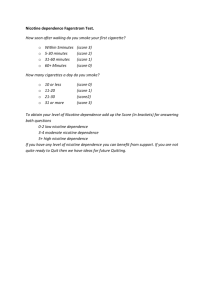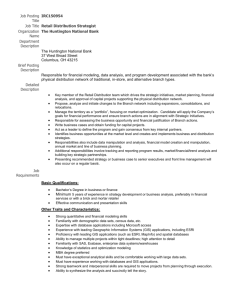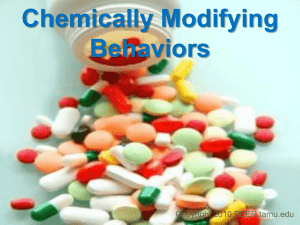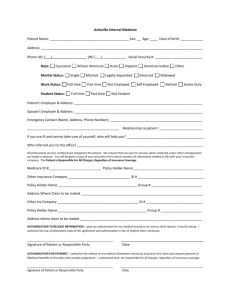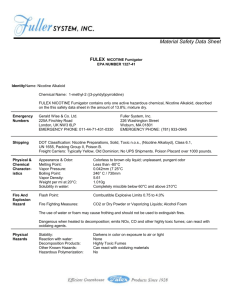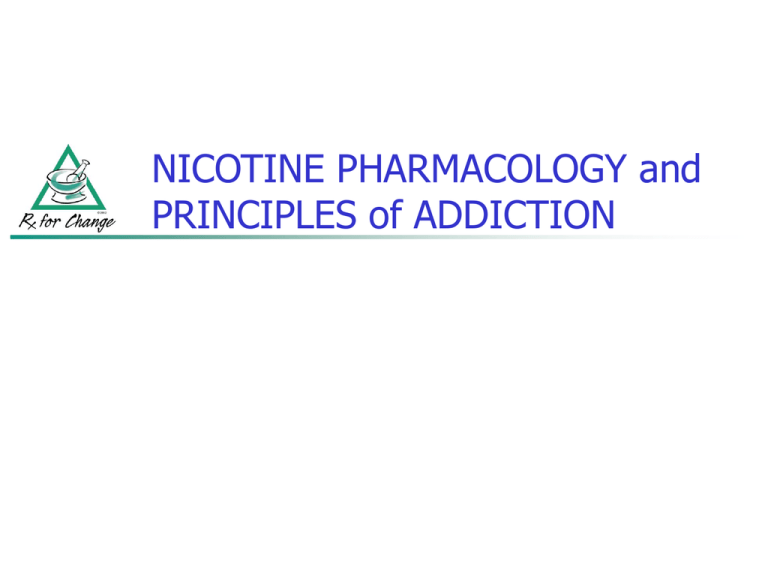
NICOTINE PHARMACOLOGY and
PRINCIPLES of ADDICTION
NICOTINE ADDICTION
U.S. Surgeon General’s Report (1988)
Cigarettes and other forms of tobacco are
addicting.
Nicotine is the drug in tobacco that causes
addiction.
The pharmacologic and behavioral processes
that determine tobacco addiction are similar to
those that determine addiction to drugs such as
heroin and cocaine.
U.S. Department of Health and Human Services. (1988). The Health Consequences
of Smoking: Nicotine Addiction. A Report of the Surgeon General.
CHEMISTRY of NICOTINE
H
Pyrrolidine ring
N
Pyridine ring
N
CH3
Nicotiana tabacum
Natural liquid alkaloid
Colorless, volatile base pKa = 8.0
PHARMACOLOGY
Pharmacokinetics
Effects of the body on the drug
Absorption
Distribution
Metabolism
Excretion
Pharmacodynamics
Effects of the drug on the body
NICOTINE ABSORPTION
Absorption is pH dependent
In acidic media
Ionized poorly absorbed across membranes
In alkaline media
Nonionized well absorbed across membranes
At physiologic pH (7.3–7.5), ~31% of nicotine is
unionized
At physiologic pH,
nicotine is readily absorbed.
NICOTINE ABSORPTION:
BUCCAL (ORAL) MUCOSA
The pH inside the mouth is 7.0.
Acidic media
(limited absorption)
Alkaline media
(significant absorption)
Cigarettes
Pipes, cigars,
spit tobacco,
oral nicotine products
Beverages can alter pH, affect absorption.
NICOTINE ABSORPTION: SKIN
and GASTROINTESTINAL TRACT
Nicotine is readily absorbed through intact skin.
Nicotine is well absorbed in the small intestine
but has low bioavailability (30%) due to firstpass hepatic metabolism.
NICOTINE ABSORPTION: LUNG
Nicotine is “distilled” from burning tobacco and
carried in tar droplets.
Nicotine is rapidly absorbed across respiratory
epithelium.
Lung pH = 7.4
Large alveolar surface area
Extensive capillary system in lung
NICOTINE DISTRIBUTION
Nicotine reaches the brain within 11 seconds.
Plasma nicotine (ng/ml)
80
70
Arterial
60
50
40
30
Venous
20
10
0
0
1
2
3
4
5
6
7
8
9
10
Minutes after light-up of cigarette
Henningfield et al. (1993). Drug Alcohol Depend 33:23–29.
NICOTINE METABOLISM
H
N
N
70–80%
cotinine
CH3
10–20%
excreted
unchanged
in urine
~ 10% other
metabolites
Metabolized
and excreted
in urine
Adapted and reprinted with permission. Benowitz et al. (1994). J Pharmacol Exp Ther 268:296–303.
NICOTINE EXCRETION
Half-life
Nicotine t½ = 2 hr
Cotinine t½ = 19 hr
Excretion
Occurs through kidneys (pH dependent;
h with acidic pH)
Through breast milk
NICOTINE
PHARMACODYNAMICS
Nicotine binds to receptors
in the brain and other
sites in the body.
Cardiovascular system
Gastrointestinal system
Other:
Neuromuscular junction
Sensory receptors
Other organs
Central nervous system
Exocrine glands
Adrenal medulla
Peripheral nervous system
Nicotine has stimulant and sedative properties.
NICOTINE
PHARMACODYNAMICS
Central nervous system
Pleasure
Arousal, enhanced vigilance
Improved task performance
Anxiety relief
Other
Appetite suppression
Increased metabolic rate
Skeletal muscle relaxation
(cont’d)
Cardiovascular system
Heart rate
Cardiac output
Blood pressure
Coronary vasoconstriction
Cutaneous vasoconstriction
NEUROCHEMICAL and RELATED
EFFECTS of NICOTINE
N Dopamine
I
C
O
T
I
Pleasure, reward
Norepinephrine
Arousal, appetite suppression
Acetylcholine
Arousal, cognitive enhancement
Glutamate
Learning, memory enhancement
Serotonin
Mood modulation, appetite suppression
Reduction of anxiety and tension
Reduction of anxiety and tension
N -Endorphin
E
GABA
Benowitz. (1999). Nicotine Tob Res 1(Suppl):S159–S163.
WHAT IS ADDICTION?
”Compulsive drug use, without
medical purpose, in the face of
negative consequences”
Alan I. Leshner, Ph.D.
Former Director, National Institute on Drug Abuse
National Institutes of Health
BIOLOGY of NICOTINE ADDICTION:
ROLE of DOPAMINE
Nicotine
stimulates
dopamine release
Nicotine addiction
is not just a bad habit.
Pleasurable feelings
Discontinuation leads to
withdrawal symptoms.
Repeat administration
Tolerance develops
DOPAMINE REWARD PATHWAY
Prefrontal
cortex
Dopamine release
Stimulation of
nicotine receptors
Nucleus
accumbens
Ventral
tegmental
area
Nicotine enters
brain
CHRONIC ADMINISTRATION of
NICOTINE: EFFECTS on the BRAIN
Human smokers have increased nicotine
receptors in the prefrontal cortex.
High
Low
Nonsmoker
Smoker
Image courtesy of George Washington University / Dr. David C. Perry
Perry et al. (1999). J Pharmacol Exp Ther 289:1545–1552.
NICOTINE PHARMACODYNAMICS:
WITHDRAWAL EFFECTS
Depression
Insomnia
Irritability/frustration/anger
Anxiety
Difficulty concentrating
Restlessness
Increased appetite/weight gain
Decreased heart rate
Cravings*
* Not considered a withdrawal symptom by DSM-IV criteria.
Most symptoms
peak 24–48 hr
after quitting and
subside within
2–4 weeks.
HANDOUT
American Psychiatric Association. (1994). DSM-IV.
Hughes et al. (1991). Arch Gen Psychiatry 48:52–59.
Hughes & Hatsukami. (1998). Tob Control 7:92–93.
NICOTINE ADDICTION CYCLE
Reprinted with permission. Benowitz. (1992). Med Clin N Am 2:415–437.
NICOTINE ADDICTION
Tobacco users maintain a minimum serum
nicotine concentration in order to
Prevent withdrawal symptoms
Maintain pleasure/arousal
Modulate mood
Users self-titrate nicotine intake by
Smoking/dipping more frequently
Smoking more intensely
Obstructing vents on low-nicotine brand cigarettes
ASSESSING
NICOTINE DEPENDENCE
Fagerström Test for Nicotine Dependence (FTND)
Developed in 1978 (8 items); revised in 1991 (6 items)
Most common research measure of nicotine dependence;
sometimes used in clinical practice
Responses coded such that higher scores indicate higher
levels of dependence
Scores range from 0 to 10; score of greater than 5
indicates substantial dependence
HANDOUT
Heatherton et al. (1991). British Journal of Addiction 86:1119–1127.
CLOSE TO HOME © 2000 John McPherson.
Reprinted with permission of UNIVERSAL PRESS SYNDICATE.
All rights reserved.
FACTORS CONTRIBUTING to
TOBACCO USE
Environment
Tobacco advertising
Conditioned stimuli
Social interactions
Physiology
Tobacco
Use
Pharmacology
Alleviation of
withdrawal symptoms
Weight control
Pleasure
Genetic predisposition
Coexisting medical
conditions
TOBACCO DEPENDENCE:
A 2-PART PROBLEM
Tobacco Dependence
Physiological
Behavioral
The addiction to nicotine
The habit of using tobacco
Treatment
Medications for cessation
Treatment
Behavior change program
Treatment should address the physiological
and the behavioral aspects of dependence.
NICOTINE PHARMACOLOGY and
ADDICTION: SUMMARY
Tobacco products are effective delivery systems for
the drug nicotine.
Nicotine is a highly addictive drug that induces a
constellation of pharmacologic effects.
Nicotine activates the dopamine reward pathway in
the brain, which reinforces continued tobacco use.
Tobacco users who are dependent on nicotine selfregulate tobacco intake to maintain pleasurable
effects and prevent withdrawal.
NICOTINE PHARMACOLOGY and
ADDICTION: SUMMARY (cont’d)
Nicotine dependence is a form of chronic brain
disease.
Tobacco use is a complex disorder involving the
interplay of the following:
Pharmacology of nicotine (pharmacokinetics and
pharmacodynamics)
Environmental factors
Physiologic factors
Treatment of tobacco use and dependence
requires a multifaceted treatment approach.

